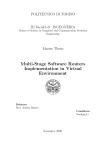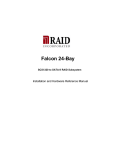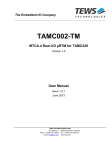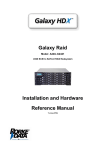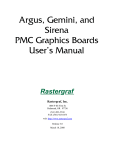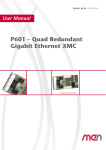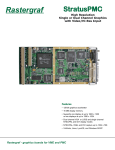Download PMX-P, PME-P Manual
Transcript
PMX-P and PME-P User’s Manual XMC or PCIe to PCI/PCI-X Adapters Rastergraf Rastergraf, Inc. 1810-J SE First St. Redmond, OR 97756 (541) 923-5530 web: http://www.rastergraf.com Release 2.1 April 29, 2014 Table of Contents INTRODUCTION.......................................................................................................... 0-1 GETTING HELP .......................................................................................................................................... 0-2 BOARD REVISIONS .................................................................................................................................... 0-2 MANUAL REVISIONS.................................................................................................................................. 0-2 NOTICES .................................................................................................................................................... 0-3 CONVENTIONS USED IN THIS MANUAL ..................................................................................................... 0-4 CHAPTER 1 GENERAL INFORMATION .............................................................. 1-1 1.1 1.1 1.2 1.3 1.4 INTRODUCTION ................................................................................................................................... 1-1 INTRODUCTION ................................................................................................................................... 1-2 PMX-P FEATURE SUMMARY .............................................................................................................. 1-3 PME-P FEATURE SUMMARY............................................................................................................... 1-4 ADDITIONAL REFERENCES .................................................................................................................. 1-5 CHAPTER 2 SPECIFICATIONS ............................................................................... 2-1 2.1 SPECIFICATIONS COMMON TO THE PMX-P AND PME-P..................................................................... 2-2 2.2 SPECIFICATIONS UNIQUE TO THE PMX-P ........................................................................................... 2-3 2.3 SPECIFICATIONS UNIQUE TO THE PME-P............................................................................................ 2-4 CHAPTER 3 CONNECTOR PINOUTS .................................................................... 3-1 3.1 PMX-P PN4 I/O CONNECTOR (PMX-P/P46) ....................................................................................... 3-2 3.2 PMX-P PN5 TARGET (VITA 42.3/PCIE) CONNECTOR ........................................................................ 3-3 3.3 PMX-P PN6 I/O CONNECTOR (PMX-P/P46) ....................................................................................... 3-4 3.4 PME-P PCI EXPRESS TARGET CONNECTOR ........................................................................................ 3-5 3.5 PMX-P AND PME-P PCI/PCI-X HOST CONNECTOR ........................................................................... 3-8 3.5.1 PCI/PCI-X Bus 32-Bit Connector ........................................................................................... 3-8 3.5.2 PCI/PCI-X Bus 64-Bit Connector Extension ........................................................................ 3-10 CHAPTER 4 INSTALLING YOUR PMX-P OR PME-P BOARD ......................... 4-1 4.1 4.2 4.3 4.4 4.5 INTRODUCTION ................................................................................................................................... 4-2 COMMENTS CONCERNING XMC BOARDS ........................................................................................... 4-2 COMMENTS CONCERNING PCIE BOARDS ............................................................................................ 4-3 UNPACKING YOUR BOARD ................................................................................................................. 4-4 CHANGING JUMPERS ........................................................................................................................... 4-4 CHAPTER 5 TROUBLESHOOTING........................................................................ 5-1 INTRODUCTION .......................................................................................................................................... 5-1 5.1 GENERAL PROCEDURES ...................................................................................................................... 5-2 5.2 DEALING WITH THE PCI BUS .............................................................................................................. 5-3 5.3 MAINTENANCE, WARRANTY, AND SERVICE........................................................................................ 5-3 Rastergraf Figures Figure 1-1 PMX-P Functional Outline ........................................................................... 1-3 Figure 1-2 PME-P Functional Outline............................................................................ 1-4 Figure 4-1 Jumper Locations .......................................................................................... 4-5 Rastergraf PME-P Introduction This manual provides information about how to configure, install, and program the Rastergraf PMX-P and PME-P PCI Express to PCI/PCI-X Adapters for 32-bit and 64-bit computers with PCI or PCI-X slots. For the sake of brevity, the term PMX/PME will be used when referring to the two boards collectively. PCI-X is a plug-compatible high performance superset of PCI and allows the bus speed to operate at up to 133 MHz. This manual is broken down into five chapters: Chapter 1: General Information Chapter 2: Specifications Chapter 3: Connector Pinouts and Cable Information Chapter 4: Installing Your PMX-P or PME-P Adapter Board Chapter 5: Troubleshooting Chapter 1 provides background material about the PMX/PME boards, and it is not essential for the hardware or software installation. If you want to perform the installation as quickly as possible, start with Chapter 4. If you have problems installing the hardware, refer to Chapter 5 for help. Introduction -1 Rastergraf Getting Help This installation manual gives specific steps to take to install your Rastergraf board. There may well be variables specific to your computer configuration that this manual does address. Normally, the default values given in this manual will work. If you have trouble installing or configuring your system, first read Chapter 6, “Troubleshooting”. If this information does not enable you to solve your problems, do one of the following: 1) call Rastergraf technical support at (541) 923-5530 2) send E-mail to [email protected] . Board Revisions This manual applies to the following board revision levels: PME-P/PMX-P Fab Rev 0 Manual Revisions Introduction-2 Revision 1.0 November 10, 2009 First released version Revision 2.0 September 7, 2010 Some revisions Revision 2.1 April 29, 2014 Minor corrections Rastergraf Notices Information contained in this manual is disclosed in confidence and may not be duplicated in full or in part by any person without prior approval of Rastergraf. Its sole purpose is to provide the user with adequately detailed documentation to effectively install and operate the equipment supplied. The use of this document for any other purpose is specifically prohibited. The information in this document is subject to change without notice. The specifications of the PMX-P and PME-P Adapter boards and other components described in this manual are subject to change without notice. Although it regrets them, Rastergraf assumes no responsibility for any errors or omissions that may occur in this manual. Customers are advised to verify all information contained in this document. The electronic equipment described herein generates, uses, and may radiate radio frequency energy, which can cause radio interference. Rastergraf assumes no liability for any damages caused by such interference. Rastergraf products are not authorized for any use as critical components in flight safety or life support equipment without the written consent of the president of Rastergraf, Inc. These products have been designed to operate in user-provided PCI-compatible computers. Connection of incompatible hardware is likely to cause serious damage. Rastergraf assumes no liability for any damages caused by such incompatibility. Rastergraf assumes no responsibility for the use or reliability of software or hardware that is not supplied by Rastergraf, or which has not been installed in accordance with this manual. Rastergraf is a trademark of Rastergraf, Inc. All other trademarks and copyrights are the property of their respective owners. Copyright © 2014 by Rastergraf, Inc. Introduction -3 Rastergraf Conventions Used In This Manual The following list summarizes the conventions used throughout this manual. Code fragments Code fragments, file, directory or path names and user/computer dialogs in the manual are presented in the courier typeface. Commands or program names Commands, or the names of executable programs, except those in code fragments, are in bold. System prompts and commands Commands in code fragments are preceded by the system prompt, a percentage sign (%), the standard prompt in UNIX’s C shell, or the hash-mark (#), the standard UNIX prompt for the Super-User. Keyboard usage <CR> stands for the key on your keyboard labeled “RETURN” or “ENTER” Introduction-4 Note Note boxes contain information either specific to one or more platforms, or interesting, background information that is not essential to the installation. Caution Caution boxes warn you about actions that can cause damage to your computer or its software. Warning! Warning! boxes warn you about actions that can cause bodily or emotional harm. Rastergraf Chapter 1 General Information PMX-P General Information 1-1 Rastergraf 1.1 Introduction The Rastergraf PMX-P and PME-P are part of Rastergraf’s line of active and passive interface adapters and carriers for PCI and CompactPCI computers The PMX-P carrier board enables an XMC module to be used in a PCI or PCI-X slot. Its design enables the PMX-P with XMC card installed to fit in one standard 32-bit or 64-bit PCI or PCI-X slot and allows adjacent slots in the computer to be occupied and for the computer to be completely closed up. Optional breakout connectors provide access to the Pn4 (PMC) and Pn6 (XMC) I/O connectors. The PME-P carrier board enables a standard PCI Express (PCIe) board to be used in a PCI or PCI-X slot. Because the PCIe board plugs into a socket at the top edge of the PME-P, the height of the combination of the two boards stands at about twice the standard height of a PCI card. By necessity, therefore, the PME-P is most practically used in a lab environment, for testing, or other non-production applications. Rastergraf produces several other PMC carriers for PCI or CompactPCI computers. For more information about them and the rest of Rastergraf’s products, please contact Rastergraf Worldwide Sales at (541) 923-5530 or consult Rastergraf’s web page at http://www.rastergraf.com. General Information 1-2 Rastergraf 1.2 PMX-P Feature Summary • Short PCI form factor board holds one VITA 42.3 XMC card • PMX-P/P46 version provides optional breakout connectors with matched-length pairs for PMC Pn4 and XMC Pn6 • 32/64-bit, 33/66/100/133 MHz PCI/PCI-X operation • PCI 2.3 and PCI-X 1.0 compliant with Universal PCI signaling • VITA 42.3 compliant supports PCIe x1, x2, or x4 on the XMC • Uses Pericom PI7C9X130 PCI Express to PCI/PCI-X Bridge • Test Point pins and LED indicators for most on-board power supplies • User selectable XMC VPWR (+5 or +12) with current limiting • Requires host-supplied +3.3V, +5V, +12V, and -12V • Universal PCI signaling • LM75 thermal sensor Figure 1-1 PMX-P Functional Outline LEDs & Test Points XMC Pn6 to Dual 68-pin VHDCI connectors with 39 matched length pairs XMC Board XMC Pn4 to 68-pin VHDCI connector with 32 matched length pairs 32/64 bit PCI/PCI-X Host Connector General Information 1-3 Rastergraf 1.3 PME-P Feature Summary • Short PCI board form factor • 32/64-bit, 33/66/100/133 MHz PCI/PCI-X operation • PCI 2.3 and PCI-X 1.0 compliant with Universal PCI signaling • PCIe 1.1 specification compliant supports PCIe x1, x2, or x4 • Uses Pericom PI7C9X130 PCI Express to PCI/PCI-X Bridge • PCIe socket accepts up to x16 (only up to x4 is actually connected) • Test Point pins and LED indicators for most on-board power supplies • Requires host-supplied +3.3V, +5V, +12V, and -12V • PCIe hot-swap is not supported • LM75 thermal sensor Figure 1-2 PME-P Functional Outline Target PCI Express Board LEDs & Test Points 32/64 bit PCI/PCI-X Host Connector General Information 1-4 Rastergraf 1.4 Additional References You can find Rastergraf documentation and other technical literature on the Rastergraf web page (http://www.rastergraf.com). The PCI Local Bus 2.3 Specification and the PCI-X1.0 Specification are maintained by the PCI Special Interest Group (PCISIG) Web Page: http://www.pcisig.com/home Some specifications are available from Rastergraf’s technical library: Web Page: http://www.rastergraf.com/Library/standards_library.htm VITA Documentation Store: Order any official VITA standard https://www.vita.com/online-store.html 1156.2-1996: IEEE Standard for Environmental Specifications for Computer Systems 1996 (includes IEEE 1101) 1156.2-1996 IEEE Standard for Environmental Specifications for Computer Systems 1386-2001 and 1386.1-2001: IEEE Standard for a Common Mezzanine Card Family: CMC and IEEE Standard Physical and Environmental Layers for PCI Mezzanine Cards 1386-2001 & 1386.1 Standard for a Common Mezzanine Card Family General Information 1-5 Rastergraf Chapter 2 Specifications Specifications 2-1 Rastergraf 2.1 Specifications Common to the PMX-P and PME-P Form Factor: Short PCI, standard height: 167.7 mm x 104.1 mm. PCI Interface: Bridged connection uses PI7C9X130 PCI/PCI-X to PCIe (x1, x2, x4). PCI is 32/64 bit, 33/66 MHz. PCI-X is 32/64 bit, 33/66/100/133 MHz. Full PCI and PCI-X functionality was verified on a Supermicro C2SBX motherboard. Indicators: Green LEDs for 3.3VAUX, +12V_PCIe, 3.3V_PCIe, +12V, -12V, 5V, 3.3V, 1.8V_VAUXS, 1.8V_VDS, 1.8V_VAS, VIO PCI, LOO, XMC VPWR = +12V. Amber LED for GPIO3 high, XMC VPWR = 5V. Red for Hi Temp, GPIO3 Low Test Points: 3.3VAUX, +12V_PCIe, 3.3V_PCIe, +12V, -12V, 5V, 3.3V, 1.8V_VAUXS, 1.8V_VDS, 1.8V_VAS, VIO PCI, LOO, XMC VPWR, Hi Temp, GPIO3, GND Printed Circuit Board: 8 layer stackup: Signal, Ground, Signal, 3.3V, VDDC (PI7C9X130 Core), Signal, Ground, Signal PCI/PCI-X trace lengths (connector to PI7C9X130) by necessity exceed standard trace length specifications because the pinout for the PI7C9X130 is backwards from that which would yield the optimum trace layout. There is no other chip that would work better. Each PCIe CLK, R, and T nets pair is matched to +/- .125 mm. PCIe net pairs don’t have to be matched pair to pair Signal traces are impedance controlled, verified with SPECCTRA advanced noise rules and simulated with less than 25 mV trace to trace, parallel or layer to layer. Standards Compatibility: PCI Revision 2.2 and PCI-X Revision 1.0. PCI Bus Loading: One PCI 2.2 compatible load Power Requirements: See Sections 2.2 and 2.3. Note that the PCI Host MUST supply 3.3V. Board PRSNT1/2 pins advertise as requiring up to 25W Weight 0.26 kg (0.56 lb) Environmental Operating temperature: 0 to 70°C Storage: -40 to +85°C Humidity: 5 to 95% non-condensing Specifications 2-2 Rastergraf 2.2 Specifications Unique to the PMX-P Target Interface One VITA 42.0 compliant XMC module. The PMX-P uses the Samtec ASP-103612-04, which is the Low Insertion Force, lead-free (preinstalled) solder balls version (see Samtec Listing. It is designed to mate with the ASP-103614-04. See Section 4.3 for more information. Due to features of the Samtec connector, there is a limit of approximately 75 – 100 insertion/removal cycles. PCIe Access Uses XMC Pn5. Follows VITA 42.3 Specification for PCI Express on XMC. Supports a single x1, x2, or x4 PCIe Gen1 connection. See Section 3.2 for more information. I/O Access XMC Front Panel and/or PMX-P breakout connectors which support PMC Pn4 to 68-pin VHDCI and XMC Pn6 to dual 68-pin VHDCI connectors: The Pn4 breakout follows VITA 46.9 P64s pinout but the I/O connector is a 68-pin VHDCI. Signals are routed as 32 matched length pairs. The set of 32 pairs match length to within +/- .125 mm. Also see Section 3.1. The Pn6 breakout follows VITA 46.9 x8+12d38s pinout but the I/O connector is two 68-pin VHDCIs. Signals are routed as 39 matched length pairs. The set of 39 pairs match length to within +/- .125 mm. Also see Section 3.3. Standards Compatibility: VITA 42.0 (XMC), VITA 42.3 (PCIe on XMC), and parts of VITA 46.9 (I/O), PCIe Specification 1.1 for PCIe signal rules and connections. Power Requirements: Board: +/-12V @ 20 mA each (est) 5V @ 20 mA (est) 3.3V @0 .4A. (est) Additional power will be consumed by the XMC module. The current/pin rating for the XMC is 1A. The XMC has 14 power pins: If VPWR = +12, you have a theoretical power of 133W! The practical power limit for an XMC is actually in the range of 15W to 20W. The PMX-P does not have current limiting on the +/-12V and 3.3V pins but this is subject to change in a later revision. However, XMC VPWR is current limited by a Polyswitch resettable fuse: for VPWR = +5V, fuse is 2.6A Hold, 5A Trip, 5s trip time +12V, fuse is 1.25A Hold, 2.5A Trip, .4s trip time Specifications 2-3 Rastergraf 2.3 Specifications Unique to the PME-P Target Interface One PCIe Specification 1.1 (Gen 1) compliant PCIe module. PCIe Access Uses top mounted socket (see Figure 1-2) without card latch. Accepts x1 to x16 PCIe card, but bridge only goes up to x4. Supports a single x1, x2, or x4 PCIe Gen1 connection. See Section 3.4 for more information. I/O Access I/O area of PCIe target board. Note that in some cases, it may be necessary to remove the PCIe sheet metal panel in order to get things to fit. Standards Compatibility: PCIe Specification 1.1 Power Requirements: Board: +/-12V @ 20 mA each 5V @ 20 mA 3.3V @0 .4A. Additional power is consumed by the PCIe module (+/12V and 3.3V. Presently, no current limiting is enforced but this is subject to change in a later revision. Specifications 2-4 Rastergraf Chapter 3 Connector Pinouts Connector Pinouts 3-1 Rastergraf 3.1 PMX-P Pn4 I/O Connector (PMX-P/P46) The PMC Pn4 Breakout Connector pinout is derived from the VITA 46.9 P64s pinout. Since the V46 connector is not appropriate for this product, the 64 pins are mapped as 32 differential pairs wired to a Honda HDRA-EC68LFDT-S-SL+ VHDCI (.8MM ) connector. The pair grouping on PMC Pn4 connector are adjacent pins on the same side of the connector (1,3; 2,4). The pairs are length matched both by pair and over the signal set at 28.425 mm +/- .125 mm (via to via). PMC Pn4 PMC Pn4 Connections are routed as 100 ohm differential pairs. If used as single-ended, one line in each pair MUST be grounded. When used as differential pairs, 100 Ohm round cable (discrete twisted pair cable) MUST BE USED. Ribbon (IDC) cable CANNOT be used because routing limitations prevented matching circuit pairs with ribbon cable pairs. VHDCI-68 1 2 3 4 1, 3 2, 3 5 6 2, 4 36, 37 7 8 5, 7 4, 5 9 10 6, 8 38, 39 1, 35 GND 11 12 9, 11 6, 7 13 14 10, 12 40, 41 15 16 13, 15 8, 9 17 18 14, 16 42, 43 19 20 17, 19 10, 11 1 21 22 18, 20 44, 45 3 23 24 21, 23 12, 13 25 26 22, 24 46, 47 28 25, 27 14, 15 30 26, 28 48, 49 32 29, 31 16, 17 27 29 31 33 34 30, 32 50, 51 35 36 33, 35 18, 19 37 38 34, 36 52, 53 40 37, 39 20, 21 38, 40 54, 55 41, 43 22, 23 42, 44 56, 57 45, 47 24, 25 46, 48 58, 59 49, 51 26, 27 50, 52 60, 61 53, 55 28, 29 54, 56 62, 63 57, 59 30, 31 58, 60 64, 65 61, 63 32, 33 39 41 43 45 42 44 46 47 48 49 50 51 52 53 54 55 56 57 58 59 60 61 62 63 64 62, 64 VHDCI 68 5 7 9 11 13 15 17 19 21 23 25 27 29 31 33 35 2 37 4 39 6 41 8 43 10 45 12 47 14 49 16 51 18 53 20 55 22 57 24 59 26 61 28 63 30 65 32 34 67 36 38 40 42 44 46 48 50 52 54 56 58 60 62 64 66 68 66, 67 34, 68 GND Molex PMC Connectors Connector Pinouts 3-2 Honda HDRA-EC68LFDT VHCDCI Connector Rastergraf 3.2 PMX-P Pn5 Target (VITA 42.3/PCIe) Connector Position 1 2 3 A B PCIe PERp0 PCIe PERn0 GND GND PCIe PERp2 PCIe PERn2 C 3.3V TRST# 3.3V D E F PCIe PERp1 PCIe PERn1 GND GND VPWR MRSTI# PCIe PERp3 PCIe PERn3 VPWR 4 GND GND TCK GND GND (MRSTO#) 5 n/c n/c 3.3V n/c n/c VPWR 6 GND GND TMS GND GND +12V 7 n/c n/c 3.3V n/c n/c VPWR 8 GND GND TDI GND GND -12V 9 RFU RFU RFU RFU RFU VPWR 10 GND GND TDO GND GND GA0 11 12 13 PCIe PETp0 PCIe PETn0 GND GND PCIe PETp2 PCIe PETn2 (MBIST#) GA1 3.3Vaux PCIe PETp1 PCIe PETn1 GND GND VPWR MPRES# PCIe PETp3 PCIe PETn3 VPWR 14 GND GND GA2 GND GND MSDA 15 n/c n/c RFU n/c n/c VPWR 16 GND GND MVMRO GND GND MSCL 17 n/c n/c RFU n/c n/c RFU 18 GND GND RFU GND GND RFU 19 REFCLK+ REFCLK- RFU (WAKE#) (ROOT0#) RFU Notes: The table above follows PCIe Electromechanical Specification (PCIeES) naming conventions. Note that for some reason VITA 42.3 Section 4.2.3 swaps the R and T part of the data pair naming relative to the definition provided in PCIeES (1.1) Section 5.1: “By default, PETpx and PETnx pins (the Transmitter differential pair of the connector) shall be connected to the PCI Express Transmitter differential pair on the system board, and to the PCI Express Receiver differential pair on the add-in card.” n/c = not connected., RFU = Reserved for Future Use VPWR can be connected to +5 or +12. See Section 4.5 for more information about power GA0, GA1, GA2, MPRES#, and MVMRO not used. Pulled up to 3.3V thru 5.1K MRSTI# connected to PCI/PCI-X RESET#. MRSTO#, MBIST#, WAKE#, and ROOT0# not connected MSDA connected to PCI/PCI-X SDA, MSCL connected to PCI/PCI-X SCL JTAG signals connected to PCI/PCI-X signals. JTAG I/O looped thru XMC board 3.3Vaux connected to PCI/PCI-X 3.3Vaux. Connector Pinouts 3-3 Rastergraf 3.3 PMX-P Pn6 I/O Connector (PMX-P/P46) The XMC Pn6 Breakout Connector pinout is is derived from the VITA 46.9 X8+12d38s pinout. Since the V46 connector is not appropriate, the 78 signal pins are mapped as 39 differential pairs wired to a Honda HDRA-E68W1LFDT1EC-SL+ VHDCI (.8MM ) dual connector. The pairs are length matched both by pair and over the signal set at 146.025 mm +/- .125 mm (via to via). XMC Pn6 A1 B1 C1 D1 E1 F1 A2 B2 C2 D2 E2 F2 A3 B3 C3 D3 E3 F3 A4 B4 C4 D4 E4 F4 A5 B5 C5 D5 E5 F5 A6 B6 C6 D6 E6 F6 A7 B7 C7 D7 E7 F7 A8 B8 C8 D8 E8 F8 A9 B9 C9 D9 E9 F9 A10 B10 C10 D10 E10 F10 A11 B11 C11 D11 E11 F11 A12 B12 C12 D12 E12 F12 Connections are routed as 100 ohm differential pairs. If used as single-ended, one line in each pair MUST be grounded. When used as differential pairs, 100 Ohm round cable (discrete twisted pair cable) MUST BE USED. Ribbon (IDC) cable CANNOT be used because routing limitations prevented matching circuit pairs with ribbon cable pairs. XMC Pn6 Upper VHDCI-68 A2, B2, D2, E2 - GND A1, B1 D1, E1 A3, B3 D3, E3 A4, B4, D4, E4 - GND A5, B5 D5, E5 A6, B6, D6, E6 - GND A7, B7 D7, E7 A8, B8, D8, E8 - GND A9, B9 D9, E9 A11, B11 D11, E11 A10, B10, D10, E10, A12, B12, D12, E12 - GND A13, B13 D13, E13 A14, B14, D14, E14 - GND A15, B15 D15, E15 A16, B16, D16, E16 - GND A17, B17 D17, E17 A19, B19 D19, E19 A18, B18, D18, E18 - GND U68, U34 - GND U67, U66 U33, U32 U65, U64 U31, U30 U63, U62, U29, U28 - GND U61, U60 U27, U26 U59, U58, U25, U24 - GND U57, U56 U23, U22 U55, U54, U21, U20 - GND U53, U52 U19, U18 U51, U50 U17, U16 U49, U48, U15, U14 - GND U47, U46 U13, U12 U45, U44, U11, U10 - GND U43, U42 U9, U8 U41, U40, U7, U6 - GND U39, U38 U5, U4 U37, U36 U3, U2 U35, U1 - GND Upper VHDCI-68 U68 U66 U64 U62 U60 U58 U56 U54 U52 U50 U48 U46 U44 U42 U40 U38 U36 Lower VHDCI-68 1 3 5 A13 B13 C13 D13 E13 F13 7 A14 B14 C14 D14 E14 F14 9 XMC Pn6 A15 B15 C15 D15 E15 F15 A16 B16 C16 D16 E16 F16 A17 B17 C17 D17 E17 F17 A18 B18 C18 D18 E18 F18 A19 B19 C19 D19 E19 F19 C1, F1 n/c C2, C3 F2, F3 C4, C5 F4, F5 C6, C7 F6, F7 C8, C9 F8, F9 C10, C11 F10, F11 C12, C13 F12, F13 C14, C15 F14, F15 Samtec XMC Connectors C16, C17 F16, F17 C18, C19 F18, F19 Connector Pinouts 3-4 Lower VHDCI-68 1, 35 - GND 2, 3 36, 37 4, 5 38, 39 6, 7, 40, 41 - GND 8, 9 42, 43 10, 11, 44, 45 - GND 12, 13 46, 47 14, 15, 48, 49 - GND 16, 17 50, 51 18, 19 52, 53 20, 21, 54, 55 - GND 22, 23 56, 57 24, 25, 58, 59 - GND 26, 27 60. 61 28, 29, 62, 63 - GND 30, 31 64, 65 32, 33 66. 67 34, 68 - GND U34 U33 U67 U32 U31 U65 U30 U29 U63 U28 U61 U26 U27 U25 U59 U24 U23 U57 U22 U21 U55 U20 U19 U53 U18 U17 U51 U16 U15 U49 U14 U13 U47 U12 U11 U45 U10 U9 U43 U8 U7 U41 U6 U5 U39 U4 U3 U37 U2 U1 U35 11 13 15 17 19 21 23 25 27 29 31 33 34 35 2 37 4 39 6 41 8 43 10 45 12 47 14 49 16 51 18 20 53 55 22 57 24 59 26 61 28 63 30 65 32 34 67 36 38 40 42 44 46 48 50 52 54 56 58 60 62 64 66 68 Honda HDRA-E68W1LFDT VHDCI Connector Rastergraf 3.4 PME-P PCI Express Target Connector Pin B1 B2 B3 B4 B5 B6 B7 B8 B9 B10 B11 Signal Name PRSNT1# +12V +12V GND SMCLK SMDAT GND 3.3V TRST# 3.3Vaux WAKE# Signal Name +12V +12V +12V GND TCK TDI TDO TMS 3.3V 3.3V PERST# Pin A1 A2 A3 A4 A5 A6 A7 A8 A9 A10 A11 KEY B12 B13 B14 B15 B16 B17 B18 B19 B20 B21 B22 B23 B24 B25 B26 B27 B28 B29 B30 B31 B32 RESV GND PETp0 PETn0 GND PRSNT2# GND GND REFCLK+ REFCLKGND PERp0 PERn0 GND End of x1 Connector PETp1 RESV PETn1 GND GND PERp1 GND PERn1 PETp2 GND PETn2 GND GND PERp2 GND PERn2 PETp3 GND PETn3 GND GND PERp3 RESV PERn3 PRSNT2# GND GND RESV End of x4 Connector A12 A13 A14 A15 A16 A17 A18 A19 A20 A21 A22 A23 A24 A25 A26 A27 A28 A29 A30 A31 A32 Connector Pinouts 3-5 Rastergraf 3.4 PME-P PCI Express Target Connector (continued) Pin B33 B34 B35 B36 B37 B38 B39 B40 B41 B42 B43 B44 B45 B46 B47 B48 B49 B50 B51 B52 B53 B54 B55 B56 B57 B58 B59 B60 B61 B62 B63 Connector Pinouts 3-6 Signal Name Signal Name n/c RESV n/c GND GND n/c GND n/c n/c GND n/c GND GND n/c GND n/c n/c GND n/c GND GND n/c GND n/c n/c GND n/c GND GND n/c PRSNT2# n/c GND GND End of x8 Connector n/c RESV n/c GND GND n/c GND n/c n/c GND n/c GND GND n/c GND n/c n/c GND n/c GND GND n/c GND n/c n/c GND n/c GND Pin A33 A34 A35 A36 A37 A38 A39 A40 A41 A42 A43 A44 A45 A46 A47 A48 A49 A50 A51 A52 A53 A54 A55 A56 A57 A58 A59 A60 A61 A62 A63 Rastergraf 3.4 PME-P PCI Express Target Connector (continued) Pin B64 B65 B66 B67 B68 B69 B70 B71 B72 B73 B74 B75 B76 B77 B78 B79 B80 B81 B82 Signal Name Signal Name GND n/c GND n/c n/c GND n/c GND GND n/c GND n/c n/c GND n/c GND GND n/c GND n/c n/c GND n/c GND GND n/c GND n/c n/c GND n/c GND GND n/c PRSNT2# n/c RESV GND End of x16 Connector Pin A64 A65 A66 A67 A68 A69 A70 A71 A72 A73 A74 A75 A76 A77 A78 A79 A80 A81 A82 Notes: The table above follows PCIe Electromechanical Specification 1.1. n/c = not connected., RESV = Reserved for Future Use +3.3 and +12 are current limited on Rev 1 (not Rev 0). See Section 4.5 for more information about power PERST# connected to PCI/PCI-X RESET#. WAKE# connected to a pullup to 3.3Vaux. 3.3Vaux connected to PCI/PCI-X 3.3Vaux. Hot Swap function not supported SMDAT connected to PCI/PCI-X SDA, SMCLK connected to PCI/PCI-X SCL JTAG signals connected to PCI/PCI-X signals. JTAG I/O looped thru PCIe board Connector Pinouts 3-7 Rastergraf 3.5 PMX-P and PME-P PCI/PCI-X Host Connector 3.5.1 PCI/PCI-X Bus 32-Bit Connector Pin B1 B2 B3 B4 B5 B6 B7 B8 B9 B10 B11 B12 B13 B14 B15 B16 B17 B18 B19 B20 B21 B22 B23 B24 B25 B26 B27 B28 B29 B30 B31 B32 Connector Pinouts 3-8 Signal Name -12V TCK GND TDO 5V 5V INTB# INTD# PRSNT1# RESV PRSNT2# Signal Name TRST +12V TMS TDI 5V INTA# INTC# 5V RESV VIO RESV KEY RESV GND PCICLK GND REQ# VIO AD[31] AD[29] GND AD[27] AD[25] 3.3V CBE[3]# AD[23] GND AD[21] AD[19] 3.3V AD[17] 3.3Vaux PCIRST# VIO GNT# GND PMEL AD[30] 3.3V AD[28] AD[26] GND AD[24] IDSEL 3.3V AD[22] AD[20] GND AD[18] AD[16] Pin A1 A2 A3 A4 A5 A6 A7 A8 A9 A10 A11 A12 A13 A14 A15 A16 A17 A18 A19 A20 A21 A22 A23 A24 A25 A26 A27 A28 A29 A30 A31 A32 Rastergraf 3.5.1 PCI/PCI-X Bus 32-Bit Connector (continued) Pin B33 B34 B35 B36 B37 B38 B39 B40 B41 B42 B43 B44 B45 B46 B47 B48 B49 B50 B51 B52 B53 B54 B55 B56 B57 B58 B59 B60 B61 B62 Signal Name CBE[2]# GND IRDY# 3.3V DEVSEL# PCIXCAP LOCK# PERR# 3.3V SERR# 3.3V CBE[1]# AD[14] GND AD[12] AD[10] M66EN Signal Name 3.3V FRAME# GND TRDY# GND STOP# 3.3V SMCLK SMDAT GND PAR AD[15] 3.3V AD[13] AD[11] GND AD[09] KEY AD[08] AD[07] 3.3V AD[05] AD[03] GND AD[01] VIO ACK64# 5V 5V CBE[0]# 3.3V AD[06] AD[04] GND AD[02] AD[00] VIO REQ64# 5V 5V Pin A33 A34 A35 A36 A37 A38 A39 A40 A41 A42 A43 A44 A45 A46 A47 A48 A49 A50 A51 A52 A53 A54 A55 A56 A57 A58 A59 A60 A61 A62 KEY Connector Pinouts 3-9 Rastergraf 3.5.2 PCI/PCI-X Bus 64-Bit Connector Extension Pin B63 B64 B65 B66 B67 B68 B69 B70 B71 B72 B73 B74 B75 B76 B77 B78 B79 B80 B81 B82 B83 B84 B85 B86 B87 B88 B89 B90 B91 B92 B93 B94 Connector Pinouts 3-10 Signal Name RESV GND CBE[6]# CBE[4]# GND AD[63] AD[61] VIO AD[59] AD[57] GND AD[55] AD[53] GND AD[51] AD[49] VIO AD[47] AD[45] GND AD[43] AD[41] GND AD[39] AD[37] VIO AD[35] AD[33] GND RESV RESV GND Signal Name GND CBE[7]# CBE[5]# VIO PAR64 AD[62] GND AD[60] AD[58] GND AD[56] AD[54] VIO AD[52] AD[50] GND AD[48] AD[46] GND AD[44] AD[42] VIO AD[40] AD[38] GND AD[36] AD[34] GND AD[32] RESV GND RESV Pin A63 A64 A65 A66 A67 A68 A69 A70 A71 A72 A73 A74 A75 A76 A77 A78 A79 A80 A81 A82 A83 A84 A85 A86 A87 A88 A89 A90 A91 A92 A93 A94 Rastergraf Chapter 4 Installing Your PMX-P or PME-P Board Installing Your PMX-P or PME-P Board 4-1 Rastergraf 4.1 Introduction Using the PMX-P or PME-P involves resolving some system integration issues. The PMX-P is a carrier for an XMC card and the PME-P is an adapter for a PCIe card. In either case, of course, you have to know what you are doing and how you plan to use the board. The PMX-P allows you to install the XMC card and actually close up the system box. The PME-P is like an extender card, and in most cases there is no way to close up the box. To see the difference, please see Figures 1-1 and 1-2. Please note that it is beyond the scope of this manual to deal with the selection and use of actual XMC or PCIe cards, solving their I/O problems, or software. We can only advise on the connection between them and the CPU host. 4.2 Comments Concerning XMC boards XMC board specifications are bit of a mess. VITA 42.0 defines the XMC card form factor, differential pair locations on the connector, and some common signals. However, 42.0 doesn’t require a particular use of the differential pairs. Several “dot”, or subspecifications, do that, and even then things are not nailed down very well. VITA 42.3 is used for implementing PCI Express (Gen1) on the XMC card. It envisions the possibilities of a single x1 to x16 link, or even two x1 to x8 links. This makes it IMPERATIVE that you know what your XMC board is designed to do BEFORE you plug it into the PMX-P. The PMX-P is designed for use with XMC boards that have a single x1 to x4 PCIe port located on Pn5. It will work with an x8, but only x4 wide link will be active. The second XMC connector, in location Pn6, is used only for I/O. It should not cause any harm to plug an x16 XMC board which would use lines on Pn6) into the PMX-P, but you still will have only an x4 PCIe connection. Please contact Rastergraf support if you have questions. WARNING: The PMX-P does NOT support Rapid I/O XMC boards. Damage to the PMX-P and/or a Rapid I/O (or other non-PCIe XMC) will likely result if you try to use such a board with the PMX-P. 4-2 Installing Your PMX-P or PME-P Board Rastergraf There are other potential problems with the XMC: a) The XMC uses a BGA-based 7x19 connector from Samtec. At the time of writing, this connector system has not been documented to be viable for more about 75 – 100 insertion/removal cycles. This is because of stress failures in the BGA solder joints. All of the mechanical stress of the connector system goes through the BGA solder joints and they are not strong enough to withstand many cycles. Please contact Rastergraf if you have questions or concerns about this. b) The VITA 42.0 XMC master specification defines 14 power pins. The power/pin is rated at 1A. Given the various supply voltages, you could theoretically draw in excess of 130W. There is nothing in the VITA 42.0 specification that controls power consumption. Note that the practical limit of the XMC card with 10 mm spacing is around 15W to 20W. Please exercise caution. See Section 2.2 for more information. 4.3 Comments Concerning PCIe boards PCIe cards are pretty straightforward. There is only one connector definition and it covers board implementations from x1 to x16 data links. It allows some optional features such as Hot Swap and JTAG. PME-P will accept a board with anything from x1 to x16 PCIe. However, the intrinsic capability of the PI7C9X130 bridge is limited to a maximum of x4, so anything beyond that is ignored. Also, you can use either PCIe Gen1 (2.5Mb/s links) or Gen2 (5 Mb/s links). But the bridge is Gen1, so the data links will operate at 2.5Mbs. At the time of this writing, no standalone Gen2 PCI/PCIe bridge is commercially available. It is unlikely that you will run into trouble trying to use any sort of PCIe card EXCEPT high-power graphics boards. The PME-P advertises to the PCI/PCI-X host on the PCI PRSNT1# and PRSNT2# pins that it is a 25 watt board, which means the host should supply that much. However, it is not clear than most systems actually limit power to the slots. Therefore, please exercise caution and don’t try to run a board that needs more than 25 watts. Installing Your PMX-P or PME-P Board 4-3 Rastergraf 4.4 Unpacking Your Board When you unpack your board, inspect the contents to see if any damage occurred in shipping. If there has been physical damage, file a claim with the carrier at once and contact Rastergraf for information regarding repair or replacement. Do not attempt to use damaged equipment. Caution Be careful not to remove the board from its antistatic bag or container until you are ready to install it. It is preferable to wear a grounded wrist strap whenever handling computer boards. 4.5 Changing Jumpers In the following subsections, please refer Figure 4-1 for jumper locations. 4.5.1 VPWR Select The XMC specification provides for the eight VPWR pins on Pn5 to be set to +5V or +12V. This means that you need to be VERY SURE of what your target XMC board expects on VPWR. To be on the safe side, the PMX-P is shipped with NO JUMPER INSTALLED. Thus, there is 0 volts on the pins. Rastergraf cannot be responsible for damage caused to your board if you select the wrong voltage. If you have any questions about what to do, please contact Rastergraf for assistance. 4.5.2 EEPROM Write Enable The PMX-P has an EEPROM that can be loaded with a variety of start-up parameters as well as manufacturing-related information. However, due to problems with Pericom’s EEPROM program it is best not to use it. A jumper must be installed to allow the EEPROM to be reprogrammed. 4-4 Installing Your PMX-P or PME-P Board Rastergraf Figure 4-1 Jumper Locations Installing Your PMX-P or PME-P Board 4-5 Rastergraf 4-6 Installing Your PMX-P or PME-P Board Rastergraf Chapter 5 Troubleshooting Introduction This chapter contains information which should assist you in tracking down installation and functional problems with your board. 5.1 General procedures 5.2 Dealing with the PCI bus 5.3 Maintenance, Warranty, and Service Troubleshooting 5-1 Rastergraf 5.1 General Procedures The PM Series boards were designed with reliability and durability in mind. Nevertheless, it may happen that a problem will occur. This section is devoted to aiding the user in tracking down the problem efficiently and quickly. You may be able to locate minor problems without technical assistance. If the problem can not be remedied, Rastergraf can then issue a Return Material Authorization (RMA) so that the board can be returned to the factory for quick repair. It can happen that installing a new board will overload the computer’s power supply if the power supply margins are exceeded. The first step in ascertaining if this is the problem is to calculate a power supply budget. This involves adding up the power requirements of each board in the system to see if you are within specification. Consult your computer’s technical manual for information on how to correctly determine this. A typical PM Series will draw a total of less than 1 Amp at +5 and +3.3 Volts. When attempting to verify that the power supply is working properly, it is not unusual to unplug everything and measure the supply without a load. While this practice is acceptable for linear supplies, switching supplies (which are very commonly used in computers) require a certain load before proper regulation is achieved. Typically, at least 5 Amps must be drawn from the +5 Volt supply before the +12 volt supplies will give the proper readings. 5-2 Troubleshooting Rastergraf 5.2 Dealing with the PCI Bus Because of the nature of the PCI protocol and the way support has been implemented in the Operating Systems for PCI bus devices such as the PM Series, it is not possible to follow the same debugging strategies. In fact, there are no address jumpers for these boards. Everything is configured in software through a set of on-board registers, which control the characteristics of the board as required by the PCI Specification. The information used to program these registers is supplied to Operating System (OS) specific functions by Rastergraf’s software. Ordinarily, several address map translations occur, including the CPU physical and virtual address maps and the CPU to PCI bridge address map. While x86 systems generally follow the standards required to meet PC compatibility and mask these details, PowerPC systems do not. Among PowerPC vendors, there are no standards which ensure interoperability among CPU boards, even when they use the same CPU and PCI bridge. Therefore, if you plan to use an PM Series board in a PowerPC based system, it is vital to ensure that Rastergraf can vouch for the board’s operation before you order the board. Otherwise, you may go crazy trying to figure out why it doesn’t work. Please contact us at [email protected] or (541) 923-5530 if you have problems. 5.3 Maintenance, Warranty, and Service Maintenance The PM Series requires no regular service, but if used in a particularly dirty environment, periodic cleaning with dry compressed air is recommended. Because of the heat generated by normal operation of the board and other boards in the system, forced crossflow ventilation is required. If forced ventilation is not used IC temperatures can rise to 60 degrees C or higher. Such high temperature operation causes IC failures and reduced MTBF. With proper forced air cooling IC temperatures will be less than 35 degrees C. Troubleshooting 5-3 Rastergraf Warranty The PM Series boards are warranted to be free from defects in material or manufacture for a period of 12 months from date of shipment from the factory. Rastergraf’s obligation under this warranty is limited to replacing or repairing (at its option) any board which is returned to the factory within this warranty period and is found by Rastergraf to be defective in proper usage. This warranty does not apply to modules which have been subjected to mechanical abuse, electrical abuse, overheating, or other improper usage. This warranty is made in lieu of all other warranties expressed or implied. All warranty repair work will be done at the Rastergraf factory. Return Policy Before returning a module the customer must first request a Return Material Authorization (RMA) number from the factory. The RMA number must be enclosed with the module when it is packed for shipment. A written description of the trouble should also be included. Customer should prepay shipping charges to the factory. Rastergraf will prepay return shipping charges to the customer. Repair work is normally done within ten working days from receipt of module. Out of Warranty Service Factory service is available for modules which are out of warranty or which have sustained damage making them ineligible for warranty repair. A flat fee will be charged for normal repairs and must be covered by a valid purchase order. If extensive repairs are required, Rastergraf will request authorization for an estimated time and materials charge. If replacement is required, additional authorization will be requested. All repair work will be done at the Rastergraf factory in Redmond, Oregon, unless otherwise designated by Rastergraf. 5-4 Troubleshooting Rastergraf Index Additional References, 1-5 conventions used in manual, 0-4 Maintenance, 5-3 PCI, 5-1, 5-3 PMB-C, 5-3 Return Policy, 5-4 RMA, 5-2, 5-4 Service, 5-4 technical support, 0-2 unpacking your board, 4-4 Warranty, 5-4








































